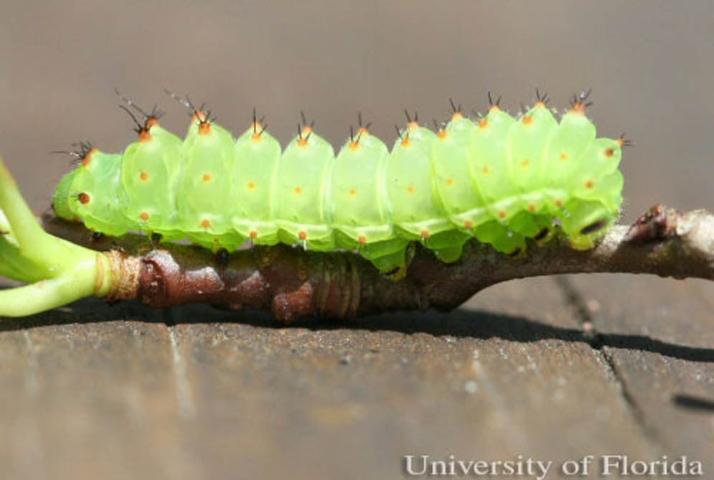
by Carrie Stevenson | Aug 5, 2021

The moon-like eyespots and long tails on its wings are identifying features of the luna moth. Photo credit: Carrie Stevenson, UF IFAS Extension
We hear about butterflies all the time–their beautiful wing patterns, how to plant entire gardens for them, and the fascinating migration patterns of monarchs. But if you look around, you might just find their night-dwelling cousins, the moths, have some pretty incredible traits, too.
I find luna moths (Actias luna) just as interesting as many of the colorful butterflies native to our area. Luna moths are considerably larger than the little brown and black moths you see fluttering around streetlights. Their wingspan can be up to 4” wide, with long, tapering tails trailing behind them. The moth is native to the entire eastern portion of the United States, but has a longer life span the further south it resides. Luna moths live year-round in Florida, with up to three generations (trivoltine) born annually. They are pale green, and adults have a furry white underbelly. Lunas are so eye-catching that they have been featured on the cover of a field guide to moths, postage stamps from the United States and other countries, and as the mascot of the insomnia medication, Lunesta.

The caterpillar of the luna moth is bright green and warns off predators by making an intimidating clicking sound. Photo credit: University of Florida
Luna moths have several celestial ties in their name. All the moths in its larger family, Saturnidae, have round eyespots (which fool would-be predators) composed of concentric circles like the rings of Saturn. “Luna” comes from the Latin for moon, after the moon-colored eyespots on its back.
Luna moth caterpillars are fat and green—the classic caterpillar—and about 2.5” long. Their preferred host plants in the south are typically sweet gum, hickory, walnut, and persimmon trees. Interestingly, the caterpillars can make a sound, typically described as a clicking noise. Biologists believe this noise-making is a defense mechanism, performed as a precursor to spitting up unpleasant fluids to fend off predators. Several studies have shown that the twisting motion of the adult luna moth’s long tails in flight can interrupt the echolocation of bats, helping the moths evade predation.
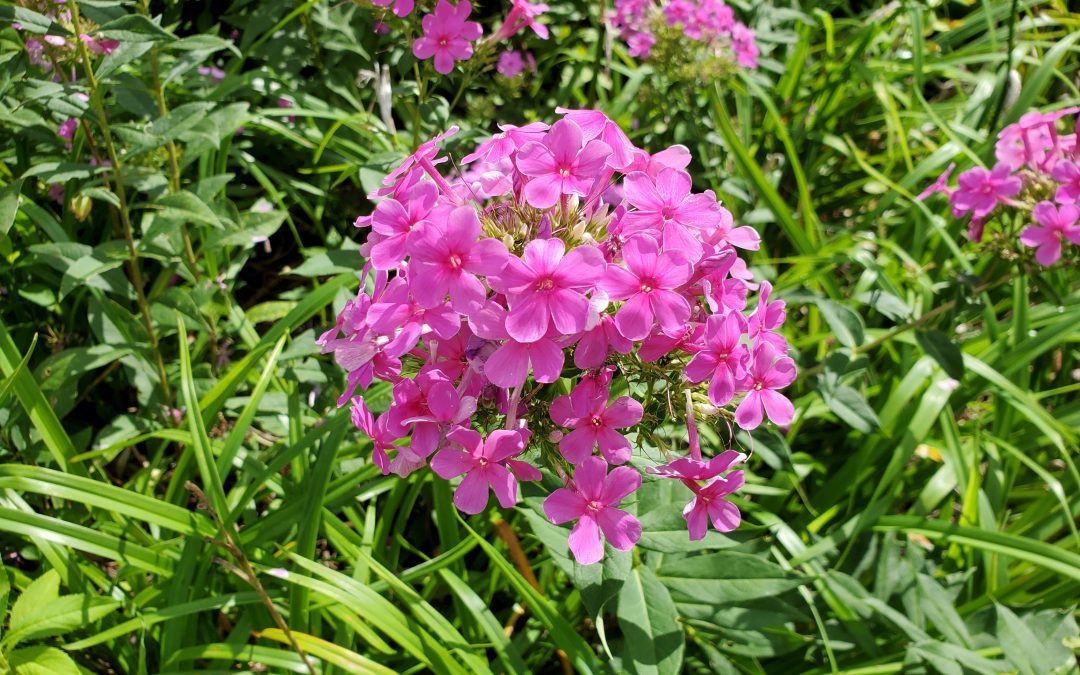
by Daniel J. Leonard | Aug 5, 2021
The number one request all would-be gardeners and budding landscape enthusiasts have is “I want something that I don’t have to take care of, tolerates the heat, blooms, and comes back every year”. That is a tall order in our climate but not an impossible one, especially if one is willing to take a step back in time and consider an old Southern passalong plant, Garden Phlox (Phlox paniculata)!

Garden Phlox (Phlox paniculata) in a Calhoun County landscape. Photo courtesy of Daniel Leonard.
This old heirloom perennial is an outstanding ornamental for Panhandle landscapes. Every spring, Garden Phlox emerges from a long winter sleep and shoots its attractive bright green foliage straight up, reaching 3-5’ in height. After hiding inconspicuously in the landscape all spring, Phlox then blasts into fiery magenta bloom during the heat of summer, beginning the show in late June. While individual Phlox flowers are only 1” wide or so, they are held prominently above the plant’s foliage in large clusters up to 8” in diameter and are about as eye-catching as flowers come. The flower show continues through July and August until finally fading out as fall rolls around. Plants then set seed and ready themselves for winter dormancy, repeating the cycle the following spring. A bonus, though individual Phlox plantings start off as small, solitary clumps, they slowly expand over the years, never over-aggressively or unwanted, into a mass of color that becomes the focal point of any landscape they occupy!
In addition to being gorgeous, Phlox is adaptable and demands very little from gardeners. The species prefers to be sited in full, blazing sun but can also handle partial shade. Just remember, the more shade Phlox is in, the fewer flowers it will produce. Site accordingly. Phlox is also extremely drought tolerant, thriving in most any semi-fertile well-drained soil. Though it can handle drought like a champ, Phlox will languish if planted in a frequently damp location. If water stands on the planting site for more than an hour or so after a big rain event, it is most likely too wet for Phlox to thrive. Once established, Phlox is not a heavy feeder either. A light application of a general-purpose fertilizer after spring emergence from winter dormancy will sustain the plants’ growth and flowering all summer long!
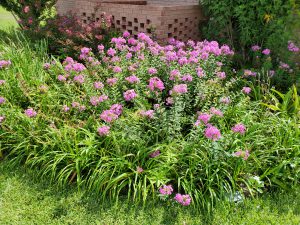
Clump of Garden Phlox in a Calhoun County landscape. Photo courtesy of Daniel Leonard.
Though the ornamental and low-maintenance attributes of plain Garden Phlox make it sound like a perfect landscape plant, it is uncommon in the modern nursery trade, having fallen out of favor as many old plants often do. The species is still a familiar site around old home places, cemeteries, abandoned buildings, and the like throughout the South, but is difficult to find in most commercial nurseries. The primary reason for this is that the commercially available modern Phlox hybrids sporting exotic flower colors and shapes are not tolerant of our growing conditions. These new Garden Phlox hybrids were bred to perform in the milder conditions of more norther climes and are extremely susceptible to the many fungal diseases brought on by Florida’s heat and humidity of summer, particularly Powdery Mildew. It’s best to avoid these newcomers and stick to the old variety with its pink flowers and ironclad constitution. Plain old Garden Phlox can be found in some independent and native plant nurseries, but the best and most rewarding method of acquisition is to make friends with someone that already has a clump and dig up a piece of theirs!
If you have been looking for a low-maintenance, high impact perennial to add to your landscape, old-fashioned Garden Phlox might be just the plant for you! For more information on Garden Phlox, other landscape perennials, passalong plants or any other horticultural topic, contact your local UF/IFAS County Extension Office. Happy Gardening!

by Mary Salinas | Jul 15, 2021
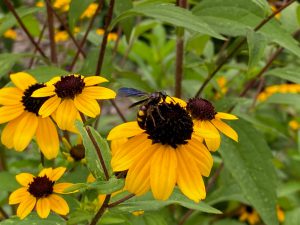
Brown-eyed Susan makes a nice addition to a pollinator garden. This one is visited by a scoliid wasp, a parasitoid of soil-inhabiting scarab beetle larvae. Photo credit: Mary Salinas, UF/IFAS Extension.
Black-eyed Susan, Rudbeckia hirta, has been a very popular garden perennial for generations. Fewer gardeners have experience with, or even heard of its’ close relative, brown-eyed Susan, Rudbeckia triloba. So, what is the difference between them?
- Brown-eyed Susan has more numerous flowers and generally flowers for a longer period in spring, summer, and fall.
- Black-eyed Susan has bigger flowers and bigger leaves.
- Both species are perennial, but the brown-eyed Susan tends to die out sooner after a few years. The good news is that both readily spread through seed to replace older plants.

Brown-eyed Susan. Photo credit: Mary Salinas, UF/IFAS Extension.
Brown-eyed Susan is native to the eastern and central United States and, although native to Florida, it has only been vouchered in the wild in 5 counties in Florida. Gardeners can find seed and plants readily online and at a few native plant nurseries. It is best to try to source wildflower seed from plants grown in the same region. Brown-eyed Susan seed from plants grown in Nebraska or Michigan may not be as well adapted to the Florida environment as locally grown seed.
If you want to add this pollinator attracting perennial to your garden, choose a spot that is sunny or partly sunny. Although it prefers moist soil, brown eyed Susan adapts to most soil types and is drought tolerant after establishment.
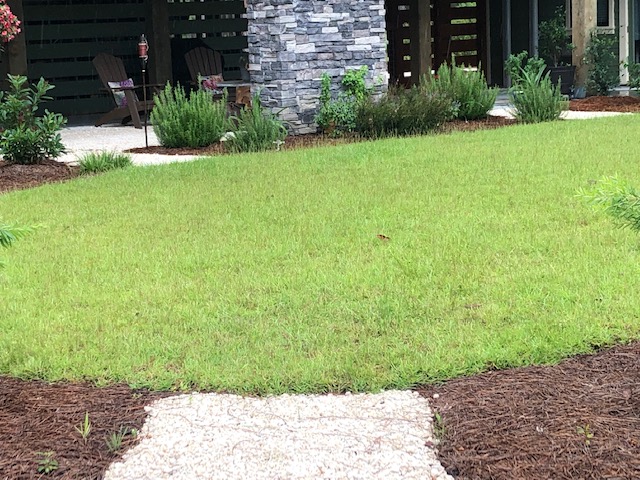
by Stephen Greer | Jul 1, 2021

Photo Courtesy: Stephen Greer
Lawn areas come in all sizes and shapes. Some are large open expanses providing long views and others are smaller versions surrounded by shrubs and trees creating a more private and secluded setting. There are a number of reasons for reducing the size of a lawn with some coming into play with your decisions. A home lawn is often an important part of the landscape that provides a place to play outdoors from picnicking, tossing the ball to taking a quite stroll.
Maintaining a healthy lawn is important to an overall performance of this part of the landscape. Several factors are involved in the success in keeping a strong and resilient lawn. Understanding the needs of a grass to remain healthy involve soil testing to address soil pH and nutrient needs plus water challenges. Misuse of fertilizer and over irrigation can be costly to you and to the overall health of the lawn. These decisions can lead to reducing lawn size to managing cost or removing underused areas.
There are big benefits to reducing your lawn from saving time in mowing, trimming and other manicuring needs to saving energy costs involving the lawn mower not to mention reducing pollution from the mower or weed eater. The reduced amounts of pesticides needed to manage weeds and disease to the lawn saves time and money.
Another way to look at the reducing the size of our lawn is there will be more space for expanding plant beds and potential tree placement. These settings increase the opportunities for a more biodiverse landscape providing shelter, protection and food options for birds and other wildlife.
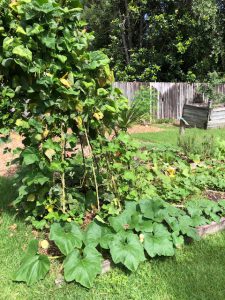
Photo Courtesy: Stephen Greer
The lawn can serve as a transition space that leads from one garden room space to another, while still offering a location to bring the lawn chair out to enjoy all that is around your lawn. Lawns and the landscape are ever changing spaces, especially as your trees and shrubs grow and mature to sizes that can directly impact the lawn performance. Often levels of shade will diminish edges and other areas of the lawn. This often will define the reduction of the lawn size moving going forward. Just remember that lawns and landscapes occupy a three-dimensional space involving the horizontal, vertical and overhead spaces. Just look around and think about what is best for you, your family and the setting.Are you more interested in developing other parts of the landscape? With many of us spending more time at home over the last year plus it gave time to think about the outdoor areas. Growing our own vegetables may be a new or expanding part of the landscape with the use of raised beds or interplanting into the existing landscape. Gardening can assist in reducing stress while at the same time providing that fresh tomato, lettuce, herbs and other fun healthy produce.
What ever your decisions are enjoy the lawn and landscape. For additional information, contact your local University of Florida IFAS Extension office located in your county.
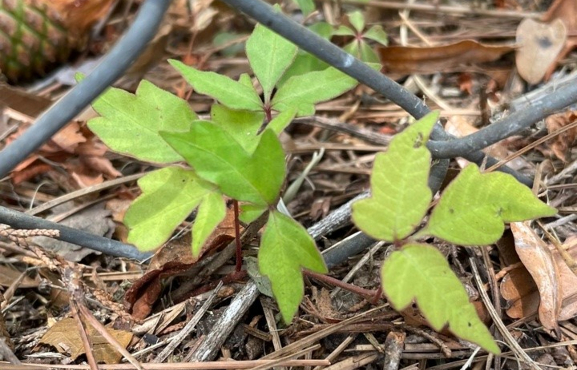
by Pat Williams | Jul 1, 2021
We work very hard to maintain our gardens and then we look up and vines are growing 20′ into the trees. I get asked frequently “what is growing up my trees?” My first answer is “probably the same things growing on your fences.” These include Smilax species, commonly called catbrier or greenbrier, Vitis rotundifolia, referred to as wild muscadine grape, Parthenocissus quinquefolia or Virginia Creeper, and the one to be most careful with, Toxicodendron radicans, known by many as Poison Ivy.
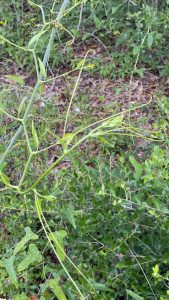
Spring growth on the Smilax vine.
Smilax is a native vine that grows quickly in spring and all summer. There are 12 species in Florida and 9 species commonly found in the Panhandle. Besides being armed with thorns on their stems and some leaves, Smilax spreads by underground stems called rhizomes. If you choose to ignore it, some species can cover your trees and the stems become woody and hard to remove. This vine also produces fruit and seeds are dispersed by birds all while the underground rhizomes are spreading under your lawns and gardens.

Smilax can quickly cover a tree trunk.
Removal can be difficult and mowing the vines only encourages more growth. When trying to remove by hand, wear heavy leather gloves and some eye protection because of the thorns. Cut the stems about three feet above the ground which allows you some stem to pull on to bring it out of your tree. You also then have a handle to pull and try to remove some of the rhizome from underground. Digging rhizomes is time consuming, but gives you piece of mind that they won’t come back immediately. Our family actually harvests the new shoots in spring and we use them like asparagus.
Wild muscadine grape is also native and difficult to remove. Most of the vines in nature are male and only produce by runners along the ground and then grow upwards. The female vine can produce 4-10 grapes in a cluster and then reseeds itself.
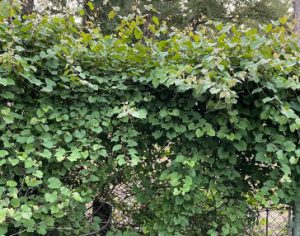
Wild muscadine grape covering a fence.
Wild grape completely covers plants and eventually the plants underneath can die. There are no thorns to contend with when removing wild grape, it is just time consuming, especially if it has taken over your fence or natural areas.
Virginia Creeper is a native vine, still considered a nursery plant in some areas of the country, and has bright red fall color.
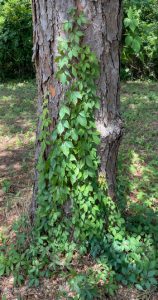
Virginia Creeper climbing a tree trunk.
It is most often confused with poison ivy because of having five leaflets per leaf whereas poison ivy only has three leaflets per leaf. It spreads by seeds, runs along the ground, and is the easiest of these four vines to remove from your property.
Poison Ivy is a native vine distinguished by its three leaflets with the individual leaflets getting up to 6″ long. This vine spreads by seeds and underground rhizomes. What makes removal of this vine difficult is the urushiol oils which causes the skin rashes and blistering.
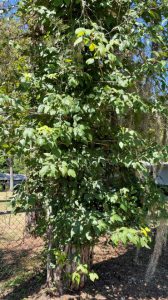
Poison ivy covering a tree trunk.
Care must be taken to cover up all skin and I recommend wearing waterproof clothes versus cotton which can absorb the oils and transfer them to your skin. Under no circumstances should these vines be put on the burn pile, the oils can become airborne and then you can inhale them.
Here are a few helpful tips when battling these native vines. First have patience and be dedicated, this removal will not happen over night. It may take a year or two to rid your property of the original vines. Be diligent though, because birds will continually land in your trees and deposit more seeds to get a fresh start. Try to remove vines when they are young and just beginning to climb your trees and fences. If you know you don’t have the time or energy to remove the vines from all your trees, at least cut the vines close to the ground to reduce flowering and new seeds. Be careful with poison ivy because falling leaves still contain oils. Once the vines start to have a new flush of growth, spray a non-selective herbicide on new growth and you should have good results. Lastly, remember one person can make a difference in trying to reduce the number of nuisance vines in our communities.
Here are some sited references to help with your removal tasks. Key to Nine Common Smilax Species of Florida. https://edis.ifas.ufl.edu/publication/fr375. Smilax is a Vine that can be Difficult to Control. http://blogs.ifas.ufl.edu/wakullaco/2017/04/21/smilax-is-a-vine-that-can-be-difficult-to-control/. The Muscadine Grape (Vitus rotundifolia Michx.) https://edis.ifas.ufl.edu/publication/hs100. Muscadine Grape Vines: Difficult to Control in Your Landscape. http://blogs.ifas.ufl.edu/wakullaco/2017/03/24/muscadine-grape-vines-difficult-to-control-in-your-landscape/. Parthenocissus quinquefolia: Virginia Creeper https://edis.ifas.ufl.edu/publication/fp454. Identification of Poison Ivy, Poison Oak, Poison Sumac, and Poisonwood. https://edis.ifas.ufl.edu/publication/EP220.


















